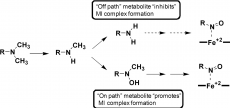

As the composition of the gut microbiota develops from birth, it is subject to complex change through life-style choices. Methylamine has demonstrated to stimulate glucose uptake through glucose transporter (GLUT4) recruitment. Methylamine metabolism has implications for rats as they induce hepatoxicity and hepatocarcinogenicity. There are implications of methylamine metabolism due to the reduction of choline. As choline is used as a precursor, it mimics the effect of a choline-deficient diet. Choline deficient diets ultimately lead to non-alcoholic fatty liver disease (NDAFLD). Choline is very important factor for human health due to it being a central nutrient as well as a contributor to phospholipid synthesis for cell membrane components. Additionally, choline plays a key role in cell signalling, lipid transport, nerve transmission and osmoregulation. The implications of a choline deficient diet are an increased risk of hepatic steatosis. This can be treated by choline infusion.
Dietary choices have strong implications for the development of insulin resistance, which is highly associated with non-alcoholic fatty liver disease. The association to insulin resistance is through hepatic triglyceride accumulation. Levels of choline are associated with cardiovascular disease risks as fat levels alter. Furthermore, choline metabolism is related to developmental liver diseases. A diet rich in choline and carnitine increases the risks of getting atherosclerosis through production of TMAO.
Dysbiosis is the imbalance of the gut microbiome and is a key indicator for a malfunctioning gut and inflamed intestines. Diseases such as obesity, chronic fatigue syndrome, cancer fatty liver disease, bacterial vaginosis, insulin resistance and inflammatory bowel disease are common in hosts with low diversity in the gut microbiota. A disturbed microbial balance leads to difficulty in microbes being able to monitor growth, leading to overgrowth or disturbed colonies. Thus, there is a relationship between microbial metabolism and gut dysbiosis. A disturbed microbiome is not favourable for efficient metabolism and thus affects methylamine metabolism. Changing levels of TMAO can be determined by numerous factors such as dysbiosis.
It is suggested that high amounts of TMAO circulating in the blood can cause stroke, heart attacks and arteriosclerosis but needs further investigation. Although there are therapeutic approaches to enable reduction in TMAO reduction, such as antibiotic treatment, reduced choline and carnitine consumption and the use of resveratrol (a prebiotic), on-going research is necessary. For research to progress, it is important to examine intracellular concentrations of TMAO, cell signalling and the effects of TMAO on proteins like enzymes so we can comprehend TMAO’s role in health and human disease. Non-alcoholic fatty liver disease is not yet fully understood, so perhaps this is a future research direction for microbial amine metabolism. If NAFLD is investigated further, there could potentially be a solution to the consequences of methylamine metabolism. Further research into the effects of diet on gut microbiota and its association to insulin resistance are emerging. A more focused understanding of host microbiota immune inflammatory axes that link to the brain, muscle liver and gut can lead to advanced research in ways of fighting disease and improving our health.
image- http://dmd.aspetjournals.org/content/38/6/963

0 Comment:
Be the first one to comment on this article.